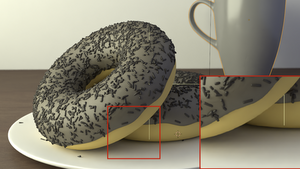Information
- Publication Type: Bachelor Thesis
- Workgroup(s)/Project(s):
- Date: April 2022
- Date (Start): 2021
- Date (End): 2022
- Matrikelnummer: 01633018
- First Supervisor:
- Keywords: incremental rendering, path tracing, GPU
Abstract
In this work I present a novel adaptive sampling algorithm for 3D editing software, developed by me and my colleagues. The algorithm is based on the idea of using knowledge about how a given user interaction affects a scene visually. We split the image into regions and order them, according to that knowledge, from most noticeably affected to least. The rendering budget can then be focused on the more affected regions earlier and on the lesser ones later in an incremental rendering process. Although this concept could probably work with other rendering methods, we designed it to be able to use path-tracing as the viewport renderer in 3D editing software without the typical grain-like noise and waiting times for sufficiently smooth rendered images this technology usually comes with. The goal of this work is to offer users of 3D editing software an as uninterrupted workflow as possible while still being able to see their work in high quality.Additional Files and Images
Weblinks
No further information available.BibTeX
@bachelorsthesis{HANN_2022_IPT,
title = "Incremental Updates of Path-Traced Scenes during Editing",
author = "Pascal Hann",
year = "2022",
abstract = "In this work I present a novel adaptive sampling algorithm
for 3D editing software, developed by me and my colleagues.
The algorithm is based on the idea of using knowledge about
how a given user interaction affects a scene visually. We
split the image into regions and order them, according to
that knowledge, from most noticeably affected to least. The
rendering budget can then be focused on the more affected
regions earlier and on the lesser ones later in an
incremental rendering process. Although this concept could
probably work with other rendering methods, we designed it
to be able to use path-tracing as the viewport renderer in
3D editing software without the typical grain-like noise and
waiting times for sufficiently smooth rendered images this
technology usually comes with. The goal of this work is to
offer users of 3D editing software an as uninterrupted
workflow as possible while still being able to see their
work in high quality.",
month = apr,
address = "Favoritenstrasse 9-11/E193-02, A-1040 Vienna, Austria",
school = "Research Unit of Computer Graphics, Institute of Visual
Computing and Human-Centered Technology, Faculty of
Informatics, TU Wien ",
keywords = "incremental rendering, path tracing, GPU",
URL = "https://www.cg.tuwien.ac.at/research/publications/2022/HANN_2022_IPT/",
}

 thesis
thesis

